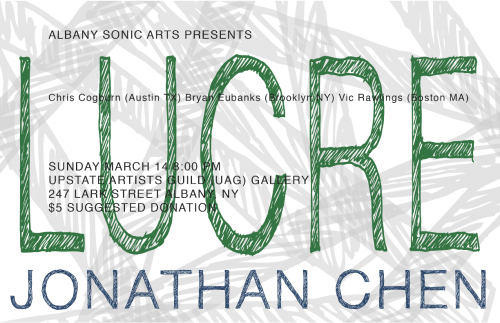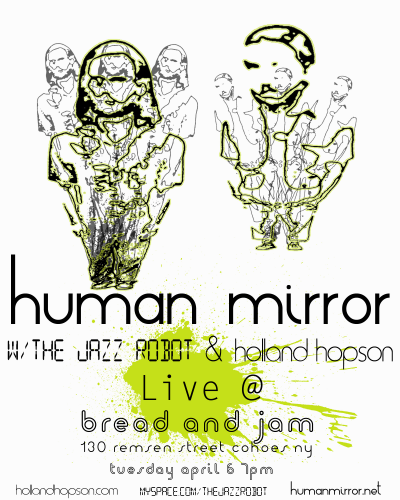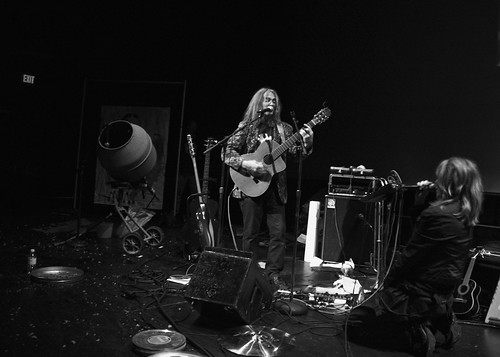I’m excited about this show on Tuesday, April 6 at Bread and Jam in Cohoes, NY featuring Human Mirror and The Jazz Robot. I’ll be opening the show with banjo and electronics. Come early; The music starts at 7pm.
Category Archives: Music
ATU Preview of Lucre/Chen

The Albany Times Union has a preview of Sunday’s Albany Sonic Arts Collective concert featuring Lucre and Jonathan Chen.
ASAC Presents Lucre and Jonathan Chen

Albany Sonic Arts Presents Lucre and Jonathan Chen
Sunday March 14 @ 8pm
Upstate Artists Guild
247 Lark St.
Albany NY
$5 suggested donation
- Lucre is the improvising trio of Chris Cogburn , Bryan Eubanks, and Vic Rawlings who perform with exposed circuits, extended ampli?ed cello, low-? modular synthesis, and stripped down percussion.
- Jonathan Chen will perform a solo set of music for electronics, viola and violin.
Chris is a good friend from my Austin days and does great work with the No Idea Festival. I’m very excited he’ll be playing in Albany. And I’m equally excited that local artist Jonathan Chen is finally getting a chance to present his work.
More information about the artists after the break…
Max Multitrack Mojo
I’m in the middle of recording a number of my pieces for banjo and electronics for a forthcoming CD. (Stay tuned for more info!) All of the works involve live, interactive processing of the banjo sound and sometimes the voice as well. This processing is done in Max and is driven by analysis of both audio inputs and sensor inputs. All of this is geek speak to say that every time I perform the piece it sounds a little different, and sometimes markedly so. This can make recording the pieces tricky. Especially since most of the music we hear is assembled like a layer cake: each part recorded separately and then mixed together after the fact (with yummy frosting…). Not a workable option for my process.
Straight to “Tape”
My previous approach to recording followed a “live to 2 track” design. I would play the piece and capture the input sounds along with whatever sounds were generated by my Max patch. The results were certainly true to life, represented my live performances well, and usually sounded fine. Occasionally, though, I’d wish for more flexibility to tweak the sounds, particularly the vocal or banjo sounds since I don’t have the luxury of recording in the world’s greatest sounding room. So I looked into ways to expand the number of available tracks.
Multitrack Multitudes
I played around with Soundflower, Rewire and Jack in various combinations and sometimes got things working pretty well. But the setups never completely gelled for me–partly because I felt constrained by the number of available outputs on my aging MOTU interface, partly because I needed as much available CPU for running my patches and couldn’t spare enough to run my DAW at the same time. So I eventually went back to recording everything in Max using a very slightly modified version of the quickrecord utility. This turned out to be a great way to break out individual tracks for further EQing during the mixing stage. One drawback was having to split the multichannel file into individual stereo or mono files. (Audacity and ProTools both do this very well. If only AudioFinder would support multichannel files…) But mostly I still felt constrained by the limited number of outputs on my audio interface; I often resorted to creating submixes of individual elements in Max in order to cram all the sounds into the available channels. With 10 outputs available I’d use the first 2 for monitoring while recording, 3 or 4 for live mics, leaving only 4 or 5 for sounds generated by Max.
Aggregrate Device – Duh!
Just the other day I had a breakthrough realization: I could use a Soundflower aggregate device to address many more output channels than are physically available on my interface. Now I’ve got channels to spare. I’m kicking myself for not thinking of this sooner. The biggest drawback? Now I’ll be spending much more time in mixing mode. I wonder when I’ll ever get this CD finished…?
Weeping Willow Street Improvisations
Last November I spent a memorable, rainy afternoon at Travis Weller’s place performing a house concert as part of his Willow Street Concert Series. Nick Hennies wowed us with music for solo percussion including an entrancing performance of Alvin Lucier’s Silver Streetcar. I played music for fretless banjo, bent electronics and computer. Then Travis and I improvised two pieces with Travis playing his Owl, a custom-built piano wire lyre with electronics. Nick joined in for the last piece of the afternoon. The rain kept us company all along.
[audio:091108_willow_street_improvisation1.mp3]091108 Willow Street Improvisation 1.mp3
[audio:091108_willow_street_improvisation2.mp3] [audio:091108_willow_street_improvisation3.mp3]One-Man Band – Pat Metheny Upgrades a 19th-Century Concept – NYTimes.com
The New York Times has a preview of Pat Metheny’s project with musical robots from LEMUR (and others): One-Man Band – Pat Metheny Upgrades a 19th-Century Concept – NYTimes.com.
I loved my short time working with the LEMURbots (residency, video, photos, Issue Project Room). Someday I hope to get (and share) the footage from my performance at LEMURplex.
LEMUR’s Eric Singer and Leif Krinkle are both quoted in the article. I can’t think of anyone better to work on a project like this.
Jill Sigman/thinkdance improvisation
This time last week I had the pleasure of working with choreographer Jill Sigman/thinkdance and videographer Peter Shapiro who were artists-in-residence at EMPAC. I recorded some sounds of the objects and materials Jill was working with and then improvised with the samples, my fretless banjo, and vocalist/composer Kristin Norderval (remotely via Skype). Peter has posted some raw footage from our sessions.
I look forward to seeing how this project continues to take shape.
Metroland Mentions Faust in Best Live Shows of 2009
Photo: http://www.flickr.com/photos/invisible-city/ / CC BY-NC-ND 2.0
Metroland critic Mike Hotter has chosen last September’s Faust show at Proctors as one of his top live events for 2009:
2. Faust, Holland Hopson, Century Plants
GE Theatre at Proctors, Sept. 30
Seminal German art-rockers Faust showed why they have been championed by avant-garde musicians for more than 30 years, while hometown openers Holland Hopson and Century Plants performed amazing outré music of their own. Hopson, in particular, is a must-see performer, a musical treasure hiding right under our noses.
Hotter’s mention of us “hometown openers” is certainly welcome, though his superlatives may not be entirely deserved.
Josh Potter chose the Boredoms as his top show of the year; I was surprised that it didn’t show up in any of the other critic’s lists. Read the entire article with all the other critic’s picks.
“Listen” Film Featuring R. Murray Schafer
Here’s an evocative short film by David New honoring R. Murray Schafer
Favorites from 2009
Here are few favorite picks of recorded media, live shows and print from 2009. As usual, I’m not much of an up-to-the-minute consumer so some of this may be old news. The exception here are the live shows, of course, so let’s start there…
Live Music
My two favorite shows were at EMPAC. The pummeling dished out by The Boredoms + 9 drummers easily takes the top spot. Garth Knox’s viola and viola d’amore might have been the polar opposite of The Boredoms but was no less riveting. I was also mightily impressed with 2009 ASAC guests Area C and Ben Bracken.
Recorded Music
The only new release on my list this year is Take Me To the Water from Dust to Digital. It’s a solid (maybe even stolid) collection of gospel–no real surprises or major standouts. But combined with the beautiful book I know I’ll be returning to this one often.
Two older CDs of music by Arthur Russel and Julius Eastman are now safely ensconced in my desert island collection:
Arthur Russel World of Echo
Where has this record been all my life? I had heard Russel’s avant-disco but was unprepared for the intimacy and sweet strangeness in this recording.
Julius Eastman Unjust Malaise
A life-changing collection of prescient music from a singular talent. There are so many standouts in this collection that it’s hard to choose a favorite.
And some assorted highlights from the year’s listening:
The Hub The Hub & Wreckin’ Ball
Tim Perkis/John Bischoff Artificial Horizon
Some of the synthesized sounds on these records date them, yet no one has better explored the potential for musicking with communication technology. The Hub is still at the heart of the genre, and sadly the genre is still too small. Maybe all those laptop orchestras with their hemi speakers will carry on some this work. They would do well to revisit these recordings.
Junior Kimbrough and the Soul Blues Boys All Night Long
Languorous sound that builds a Calatrava-style bridge between a juke-joint in Mississippi and the sacred sites of minimalism, drone and raga. On second thought, maybe that juke-joint in Mississippi IS a sacred site of minimalism, drone and raga.
Art of Field Recording Volume I
Another Dust to Digital release. I lived with these recordings for most of the year–and won’t be forgetting them soon.
Gloria Coates Symphonies Nos. 1, 7 and 14
This was recommended to me when it first came out. I’m sorry I missed it until this year.
Books
This is Your Brain on Music by Daniel Levitan was probably the most fun I’ve had thinking about music and sound in a while. His Six Songs is less interesting/convincing, but a good intro to questions about music and evolution.
I enjoyed John Adams‘s Hallelujah Junction more than I expected, based on my experience with Adams’ music. (When will John Luther Adams write a book?) I found his tales about his origins and development illuminating and his writing refreshingly frank. It was especially interesting to read about his life in San Francisco during the 1960s which leads to…
The San Francisco Tape Music Center: an excellent overview of an under-appreciated group of electronic music pioneers and their fascinating intersections with popular culture. This collection puts a new spin on the usual Columbia/Princeton/Bell Laboratory history of electronic music in the US.
Music Technology
I expected 2009 to be about Max for Live, but I never got around to buying Live and then had no reason to get Max for Live. Instead, the one piece of music gear that’s made the most impact on my work in 2009 is an 1860’s style fretless tackhead banjo built by Eric Prust.
Back to the software side, the most notable music software I used this year was for the iPhone
Cleartune is easily the best tuner I’ve ever used. It still makes me a little giddy at how wonderful it is to be able to switch between equal tempered tunings and all manner of Pythagorean, just, meantone and historical tunings. My trusty clip-on tuner finally died this year; I’m not sure I’ll replace it.
SoundLevel is a free, bare-bones sound level meter app. I haven’t upgraded to SoundLevel Pro because the free app does me just fine. The convenience of always having a sound level meter on hand means that I’m much more likely to use it. In fact, it’s become an important step every time I set up a PA or go to a friend’s house to listen to mixes. Not to mention the ability to quickly check how loud that blender really is–time to put in earplugs!
On the productivity/inspiration side of things, OmniFocus for iPhone is essential for me. And the iPhone’s built-in Voice Memos app has become my favorite way to capture a sonic idea or lyric phrase–if only there were a better way to offload those files to my machine rather than having to go through iTunes…
Looking ahead to 2010
Maybe 2010 will be my time for Live and Max for Live. I’ve just started dipping into the Pinewoods International Collection of folk tunes and I expect the book will occupy me for most of next year. I’m hoping that by 2011 I’ll be able to frail my way with ease through all those odd time signatures. Finally, I’m looking forward to making more field recordings with my recently beefed-up rig which now includes a Fostex FR2-LE and a Rode Blimp.


